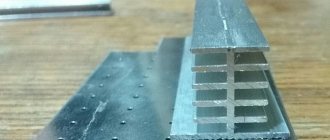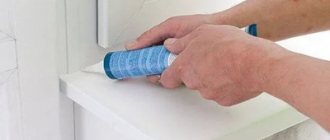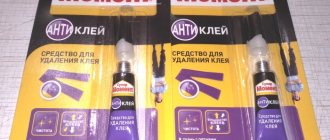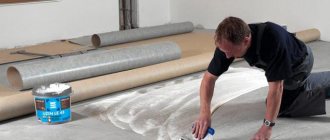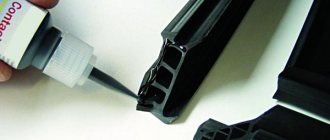Welcome to the “Our Secret” website!
Recently I encountered a problem - how to remove Cosmofen glue? It arose after the box in the “wall” that I bought for a new apartment broke. To seal it, after a series of experiments, Cosmofen became the best remedy.
He glued the box together, and firmly, but bad luck - a few drops leaked and stained the linoleum. It’s not that I glued on a bare floor, but the newspaper I laid on it did not save the floor from a very sticky and then hardened spot of glue, and even with newspaper text printed on it.
How can you dissolve cyanoacrylate glue?
The best way to remove superglue from your hands is to use concentrated dimethyl sulfoxide - it is freely sold in pharmacies under the trade name "Dimexide". Even adhesive joints can be dissolved with Dimexide, although this may take several hours.
Interesting materials:
How to clean old film from plastic windows? How to clean old tiles from grout? How to remove rust from an old horseshoe at home? How to clean old rust in a toilet? How to clean old rust? How to clean an old duck bin? How to remove paint from an old bathtub? How to clean an old bathtub? How to clean dirt from an old sofa? How to clean an old sofa?
Anti-glue - the best way to wash your hands of dried glue
If you are a prudent person and knowing in advance that you will have to work with glue, you can immediately purchase a product called “Anti-Glue Supermoment”. It can be purchased at any hardware or construction store. Anti-glue does an excellent job of removing glue from various surfaces, including easily removing it from the skin of your hands. Apply the product to a sponge and wipe the contaminated surfaces; after a while, the glue stains will dissolve.
In the same way, the remains of dried glue can be removed from fabric, wood and any other surface.
If you were unable to buy Anti-Glue, you can purchase Dimexide solution at the pharmacy. Apply a small amount of this substance to the glue stain for a few minutes to remove it completely. But if you can’t get rid of the glue right away, you need to repeat the procedure. When the glue stain has dissolved, the marks should be washed with warm water.
When it is not possible to buy a special preparation for removing hardened glue, you can use improvised means that can always be found in every home.
Features of removing stains from different surfaces
Depending on the type of surface on which the glue was applied, the methods for cleaning it differ:
- Plastic should not be exposed to heat. It may melt when exposed to high temperatures.
- glass with sandpaper or any sharp objects. Scratches that appear not only worsen the appearance of the product, but can also cause its destruction.
- Clothes are not treated with caustic compounds. This applies to any aggressive solvents.
- Wood is resistant to both mechanical and chemical cleaning, but varnished surfaces are not treated with liquids containing acetone.
- Bottles after processing are used for storing food products. Therefore, it is necessary to remove any cleaning agent residues from them especially carefully, or use vinegar, soda or oil for this purpose.
- Wallpaper is afraid of prolonged contact with liquid substances.
- Leather shoes are sensitive to any impact. Therefore, you can get rid of glue stains with a limited set of means: vegetable oil, warm water or freezing.
- Tiles, like metal , should not be cleaned with sharp objects, so as not to spoil its appearance.
- Human skin is sensitive to various aggressive substances. Therefore, to remove traces of glue, it is better to use a warm soapy solution or vegetable oil.
- Linoleum can fade under the influence of solvents, and sharp objects leave deep scratches on it.
How to clean cosmofen from glass
Welcome to the “Our Secret” website!
Recently I encountered a problem - how to remove Cosmofen glue? It arose after the box in the “wall” that I bought for a new apartment broke. To seal it, after a series of experiments, Cosmofen became the best remedy.
He glued the box together, and firmly, but bad luck - a few drops leaked and stained the linoleum. It’s not that I glued on a bare floor, but the newspaper I laid on it did not save the floor from a very sticky and then hardened spot of glue, and even with newspaper text printed on it.
Varieties
Polyurethane Cosmofen is available in several modifications.
Cosmofen CA 12
Cosmofen CA 12 glue is a cyanoacrylate composition. It is intended for plastic.
Other materials can also be glued, but plastic exhibits better adhesive properties.
Cosmofen CA 12 glues EPDM seal profiles and fixes them on aluminum and PVC profiles. You can connect silicone seals, rubber, elastomers, and bond polymers.
The composition completely applied to the bonded surface hardens after 16 hours, and the initial adhesion to the material occurs after 15 seconds. The glued seam is strong and transparent. Superglue comes in small plastic bottles with a long, thin spout.
Cosmoplast 500
Cosmoplast 500 is a cyanoacrylate-based adhesive. It is sold in plastic bottles adapted for targeted application of the product. You can connect different materials, including rubber, plastic.
The composition was used:
- when repairing electronics;
- in the production of windows;
- in the production of advertising products;
- in medicine, mechanical engineering.
Fixation occurs instantly. Therefore, the parts to be connected must initially be placed in the correct position.
The seam is durable and waterproof. The density of the mixture is 1.05 g/cubic. cm, density – 20 mPas. The crystallized seam is resistant to high temperatures and aggressive substances.
The maximum operating temperature for glued substrates is +80°C. If you expose the pasted material to this temperature, it will come unstuck.
Other brands of Cosmofen glue
- Cosmoplast 505, Cosmo CA-500.120 - these mixtures harden extremely quickly. If they are mixed with a primer of the same brand, the strength characteristics of the composition can be significantly increased. They can glue polyamides, polyolefins, oilcloth, silicone seals, elastomers, rubber, and plastic. Cosmoplast 505 is actively used in shoe repair and for gluing leather.
- Cosmo CA130 (Cosmoplast 515) – compositions for gluing decorative film on any substrate. The film sticks without bubbles. The seam crystallizes in 3 minutes, which allows you to quickly change the position of the film and eliminate emerging defects. The composition is used in the engineering industry and other industries.
- Cosmo CA140 (Cosmoplast 516) – is capable of gluing metal parts, plastic, and rubber seals together.
- Cosmo CA170 (Cosmoplast 564) - can connect highly porous surfaces, it is widely used in the installation of sewer systems and in the manufacture of seals.
- Cosmo CA500.200 adhesive is a means for quick fixation. You can connect parts made of rubber, plastics, metals, elastomers, leather, ceramics, stone, and other popular materials. The seam is strong, rigid, resistant to high temperatures, and does not contain solvents.
- Cosmofen Plus is a white composition, which, when applied, creates a super-strong seam.
To accelerate the polymerization of the applied adhesive composition, an additional cyanoacrylate adhesive activator “AC-12” is used. It is produced in aerosol form and acts as a catalyst that helps glue parts together faster.
First steps with a fresh stain
You might be interested in reading the article Cleaning Adhesive from Plastic. Read here...
Further work depends on the type of fabric, because some types of products can have an aggressive effect on its structure. It’s good if the clothes still have labels indicating how to care for them. If they are not there, then you will have to check the effect of each means at hand for aggressiveness.
The decision on how to remove glue from clothes should be immediate.
Manufacturer
Superglue Cosmofen from the German company Weiss. In Russia it is produced under the Resolen brand. It is used in the same industries as Cosmofen.
Resolen is resistant to alkalis, acids, petroleum products, sea water, and other aggressive environments. The composition can be used at temperatures from -60 to +280°C, it has high abrasive resistance and elasticity. Threshold operating temperature +320°C. Resolen is available in 50 ml packs. Rtline glue is also available. Areas of application similar to Cosmofen.
Glue removal tools
To decide how to remove superglue from glass, you need to know that it is unacceptable to use sharp objects for this purpose. A sharp metal knife or blade is not suitable for cleaning glass. They can lead to deep damage and fail to complete the main task.
How to remove superglue from glass? Cleaning supplies that will remove super glue from glass without damaging the surface include:
- rough rags;
- a soft cloth (for example, microfiber or other soft fabric);
- cotton swabs and sticks;
- plastic or wooden spatula (any old plastic card will work as a scraper);
- foam sponge.
Just in case, you need to have some sharp object on hand, such as a metal knife or blade.
How to quickly remove using special means?
To remove superglue, manufacturers of these products produce special solvents. Their main purpose is to dissolve (soften) the glue, after which it can be easily removed with a brush.
Anticlay Super Moment
This tool is one of the most popular. It is produced by Henkel (Germany). Anti-glue has a synthetic chemical composition.
The product is available in 5 gram tubes. In most cases, this volume is enough for one application. The price of the package is around 100-120 rubles.
Using anti-glue is very simple:
- The cardboard packaging is opened.
- The cap, consisting of two parts, is screwed tightly onto the tube.
- The top cover is removed from the cap.
- Using a thin nozzle, the product is squeezed directly onto the stained area.
- After the glue stain has become softer, it is cleaned with a washcloth.
- Hands are washed thoroughly.
Advantages of use:
- efficiency;
- Possibility of use on various surfaces, not only on skin;
- good price;
- ease of use.
Minuses:
- small volume;
- chemical composition.
After the product has taken effect, it must be washed off thoroughly.
Cleaner Contact
The cleaner is designed to remove superglue from various surfaces. You can also use it to clean your hands. Contact can be purchased in tube form or in a bottle with a brush. Its price is about 100 rubles per package.
The use of the product is similar to the previous drug . You should not leave the cleanser on the skin too long, so as not to provoke a negative reaction on the skin.
If brushing does not help much, it is recommended to use a pumice stone.
Remover Second Anti-Glue
Anti-glue is suitable for removing superglue from various manufacturers. The packaging is standard, its volume is 3 grams. The product has an affordable price - from 60 rubles per piece. The product allows you to remove glue from dirty hands and other objects.
The product has standard packaging for such drugs, it is not difficult to use, the price is affordable, and it has an effect . You should not keep anti-glue on your skin for a long time, as it has a synthetic composition.
Salt scrub and bath
Sea or regular coarse salt is suitable for this method. You need to make a scrub from it. To do this, add salt to a small amount of any cream. Apply this composition to the area of skin with glue. Leave for 3-5 minutes, and then use a sponge or brush to clean the skin of glue.
A salt bath also works well with superglue. It is enough to dissolve a small amount of sea or coarse table salt in a container of hot water. Place your hands in the resulting mixture for 20 minutes, if necessary, extend the procedure. Then remove the glue with tweezers. After this, rinse the skin under running water, wipe dry and lubricate with moisturizer.
Specifications
| Characteristic | Meaning |
| Density | From 0.99 g/cc |
| Viscosity | Average, 70 mPa |
| Hardening time | 15-60 s |
| Maximum adhesion time | 2-4 min. |
| Air temperature during use | Above +5°C with air humidity no more than 60% |
| Air temperature for maximum drying speed | Above +20°C with air humidity no more than 60% |
| Seam color after drying | Transparent or white |
| Best before date | 1 year |
The glue dries quickly due to the presence of cyanoacrylate in the composition. The composition is flammable, so it should not be used near open flame sources. The ignition temperature of cyanoacrylate glue is +212°C.
Acetone and warm water will help get rid of glue that has hardened on your hands.
Using water and soap, you can easily remove PVA glue from your hands, but if super glue has hardened on your hands, you will have to use other methods.
You can remove the glue from your hands using acetone or nail polish remover. This simple method cannot be called fast and effective. We'll have to be patient. When you apply acetone to the contaminated area of skin, the liquid will slightly weaken the effect of the glue, but will not completely get rid of it. After you treat your skin with acetone, you will have to wash your hands thoroughly with soap and warm water for a long time.
Water will seep into the small gaps created by using acetone between your skin and the glue, and gradually you will be able to wash the Moment glue off your hands.
When washing, it is better to wipe the skin with a sponge. This way, the dried film will be wiped off faster in small pieces.
If you don’t have acetone on hand, you can do without chemicals. Fingers stained with glue should be kept in warm water with detergent for 10 minutes. Adhesives contain cyanoacrylate. This substance tends to separate in warm water. After the bath, you will need to rub your fingers with a sponge and rinse with running water.
If no measures are taken to remove superglue residue from your hands. The layer of glue will disappear on its own in a couple of days. Since the glue will peel off with dead skin particles. To speed up this process, simply wash your hands with soap and warm water more often.
Review of effective methods
Before washing cosmofen from plastic, you need to analyze the following factors: the intensity of surface contamination, the age of the dried adhesive mass. Based on this, you will have to resort to different cleaning options. There is a mechanical method, as well as using non-aggressive and aggressive means.
Review of non-aggressive methods for cleaning glue residues
Plastic is characterized by high strength, but it is regularly exposed to aggressive environmental influences. This usually happens when the quality of the material is low or its thickness is small. In this case, it is impossible to use chemically aggressive substances to wash cosmofen.
Available methods using non-aggressive means:
- It is recommended to choose a glass cleaner to wash away fresh stains that have not yet had time to be absorbed into the structure of the material and dry. Sometimes, it is possible to achieve the desired result after several uses.
- Water is an effective but not aggressive substance. With prolonged exposure to the stain, it softens it. It is recommended to use water whose temperature is not lower than 40 degrees. The preferred duration of exposure is about 24 hours; it is necessary to observe how the adhesive mass reacts. It is worth noting that it makes sense to use water if the stain is no more than a month old.
- Soap solutions and rags will also help remove hated stains. This method is applicable to remove not only fresh stains, but also old ones. To prepare the solution, it is recommended to use bar soap (preferably laundry soap) or liquid soap. Fresh stains can usually be removed quickly. It is more difficult to wipe off old glue; it will take at least two hours for continuous exposure.
- Alcohol with a high ethanol concentration (95%). It is worth noting that it is recommended to wipe off small stains in this way, since the substance helps soften the plastic.
Often, when removing contaminants, it is necessary to combine the use of non-aggressive substances with a mechanical cleaning method, since the components do not dissolve the glue, but only soften it.
Mechanical methods
If you have an arsenal of sharp knives at home, you can carefully try to cut off the dried cosmofen. But it is advisable to resort to this method only if the contamination has a large area. When cutting, you need to point the knife parallel to the floor, otherwise the likelihood that the plastic will be scratched increases significantly. As an alternative to a knife, you can use a blade. If the movements are smooth and careful, you will be able to accurately complete the task.
Egg and lemon mixture
This method requires 2 raw chicken eggs and half a lemon wedge. In any container, whisk the eggs with the lemon until foam forms. Then place your hand in the resulting liquid and hold for 10-15 minutes. The glue will begin to peel off from the skin and can be rubbed off with a sponge. If necessary, repeat the entire procedure until traces of superglue are completely removed from your hands. Rinse the area to be treated under running water and lubricate with moisturizer.
Areas of use
- Cosmofen can be used to glue plastic together. Suitable for PVC, polypropylene. For plastic windows, it is used only when connecting sealing profiles. They glue window joints with it. Used for repairing doors, fittings, and windows. Properties do not allow gluing porous plastic. The product is absorbed into the pores, the adhesive seam loses its strength.
- Cosmofen is a popular adhesive for suspended ceilings.
- They are constantly used in mechanical engineering, shipbuilding and aircraft construction.
- In medicine it is used in the production of orthopedic shoes and in dentistry.
- Glue wood, fiberboard, chipboard.
- Used to make jewelry and in the production of toys.
- Glues together sailboat models.
- Used in plumbing work, you can glue pipes, drains, fittings.
- Cosmofen is used to glue electronic and optical devices during assembly.
- You can connect rubber, metal, glass.
- Mixed with primer to create an adhesive for silicone and thermoplastic elastomers.
Helpful information
Tips that will come in handy when removing adhesive traces:
You need to start processing as early as possible. The longer the adhesive remains on the surface, the more difficult it is to remove.- To remove glue, use a cotton pad or a light cloth. If the fabric is colored, the pigment can be absorbed from it into the surface being treated. This will require additional cleaning.
- After removing the glue, the surface to be treated should be rinsed with clean water or wiped with a damp cloth to remove any remaining solvent.
- When using aggressive compounds, it is recommended to test them on an inconspicuous area.
- When working with volatile substances, you must protect your respiratory system with a mask. Caustic compounds require the use of gloves.
Features of superglue
Superglue has the following advantages:
- high setting speed - from 5 seconds to 1 minute;
- resistance to a wide temperature range. The adhesive seam does not break in the cold and remains just as strong at high temperatures. The range is from -40 to +60С;
- water resistance.
Superglue is always sold in small packages, since if the seal of the tube is broken, it quickly loses its adhesive properties.
Once on the skin, superglue dries quickly when exposed to open air. There is an unpleasant feeling of tightness. If fingers accidentally stick together, pain may occur. That is why when working with Moment or other brands of superglue, it is recommended to wear gloves.
Glass glue removers
How to remove super glue from glass:
- production compounds - anti-glue;
- folk remedies - hot water;
- chemicals - dimexide, ammonia;
- household products - glass cleaner;
- mechanically - with tape, plastic card.
When using special compounds and chemicals, you must carefully read the instructions for their use and strictly follow precautions and safety precautions.
Anticlean
How to remove super glue from glass? Super glue, which has high quality characteristics, is practically impossible to clean with water, household and chemical substances, and is resistant to sudden temperature changes. In this regard, it will be very difficult to get rid of its traces using improvised means, and in some severe cases it will be impossible. If the adhesive stain formed a long time ago, is very dry and occupies a large area, it can only be removed by professional means.
These include substances marked “Anti-glue”. You can buy it in any specialized stores (for example, where they sell building materials, they always offer a wide selection of anti-glue from different manufacturers) or in hardware departments, as well as in auto parts stores. Anti-glue is often used to remove glue from windows and other car parts. It quickly performs its task without damaging the tinting or the car windows themselves.
The disadvantages of anti-glue from any manufacturer primarily include its high toxicity. Therefore, while working, it is necessary to have rubberized gloves and a protective face mask to avoid damage to the skin and mucous membranes of the eyes and nasal cavity.
Processing should be carried out in a well-ventilated room or in the fresh air. It is undesirable for children and animals to be in the work area.
The second significant disadvantage of anti-glue is the small volume of the tube. To wash super glue from a large area of glass, you will have to use more than one package and spend a lot of money. Therefore, large areas, as a rule, are not treated with anti-glue.
How to remove superglue from glass using a special composition? Before use, you must carefully study the instructions. The procedure is as follows:
- Apply anti-glue to a household sponge or napkin.
- We carefully wipe the adhesive stain, trying to act in a targeted manner, without smearing the product all over the glass. This way, it will be easier to wipe off the mark and not leave unnecessary streaks.
- Leave the applied composition for the time specified in the instructions (usually 20-25 minutes).
- After time, wash the substance with a dry, rough cloth.
- If the stain is very dry, it is possible that the treatment will have to be carried out several times until the stain disappears completely.
The algorithm of actions can be seen in the video.
Universal wiper
Modern windshield wipers, purchased from a regular hardware store, are widely used to remove sticky substances. The secret lies in its multicomponent composition, namely the content of ethyl alcohol.
To get rid of unnecessary glue on glass using a glass cleaner, you need to:
- Spray the product onto the problem spot.
- Wait 25-30 minutes, but do not let it dry.
- Carefully remove the glue with a wooden or plastic spatula.
After applying glass cleaner to the glue, a complex reaction begins, in which the latter becomes soft and viscous. Subsequently, it can be easy to clean off with a special spatula or even a cotton swab.
Gasoline and household solvents
The use of kerosene-based household solvents, or gasoline or kerosene itself, will help you cope perfectly with unwanted splashes of superglue.
How to clean super glue from glass using gasoline solvents? For cleaning you will need:
- Wet a rag or cotton wool with the substance.
- Apply to the contaminated area.
- Wait about half an hour.
- Repeat the procedure and wait another 15 minutes.
- Scrape off the softened glue with a spatula.
Advantages and disadvantages
Cosmofen takes a few seconds to dry.
- The convenient form of packaging in the form of a plastic jar with a long cone-shaped spout allows you to apply it to the surfaces to be glued without additional tools.
- This is a 5-second glue, since durable gluing of surfaces treated with it occurs in just 5 seconds.
- Fixation of glued surfaces is achieved without the use of a press. For a strong connection, it is enough to press the glued surfaces together with your palms and hold them in this state for 5 seconds.
- Cosmofen glue reaches maximum strength in just 16 hours.
- This is superglue for metal surfaces that have been previously cleaned of rust and degreased.
- The product is economical; a few grams are enough for gluing.
- Contains all components for rapid hardening. No additional components are needed.
- Does not fade in the sun, crystallized shock does not delaminate, does not change color.
- Available in a bottle. It can be carried and used.
Flaws:
- glued parts must not be exposed to high temperatures or water;
- It is impossible to properly glue porous materials with Cosmofen.
Aggressive means
It is necessary to use aggressive substances for cleaning with extreme caution, because... they can ruin the thing completely.
The most effective of them include:
Before using one of the above products, it is recommended to test on a small, inconspicuous place and only then begin work.
“Moment” and “Second” glues are considered especially durable. Therefore, the question most often arises is how to remove glue from plastic.
In this case, experts advise using anti-adhesive from the same manufacturer, because it contains exactly those components that can remove traces of the adhesive in full.
An alternative is dimexide, which can be easily purchased at any pharmacy.
How to remove super glue from plastic
Before you think about how to clean super glue from plastic, you should understand the quality of the surface being treated. Thin and flexible plastic requires more careful care. Aggressive cleaning methods can damage it, leave streaks, cause discoloration, and sometimes even melt the treated area.
Using rough materials such as a hard cloth or wire wool, a knife, or a blade can leave scratches, chips and other damage on the item. Therefore, thin plastic must be handled with extreme care.
It is important to take precautions both when applying super glue and when removing it, especially if you use aggressive cleaning methods. For work you will need a pair of gloves and a protective face mask.
So, there are three main ways to remove super glue from plastic. This:
- non-aggressive substances;
- aggressive substances;
- mechanical methods of influence.
Let's talk about each of them in more detail.

